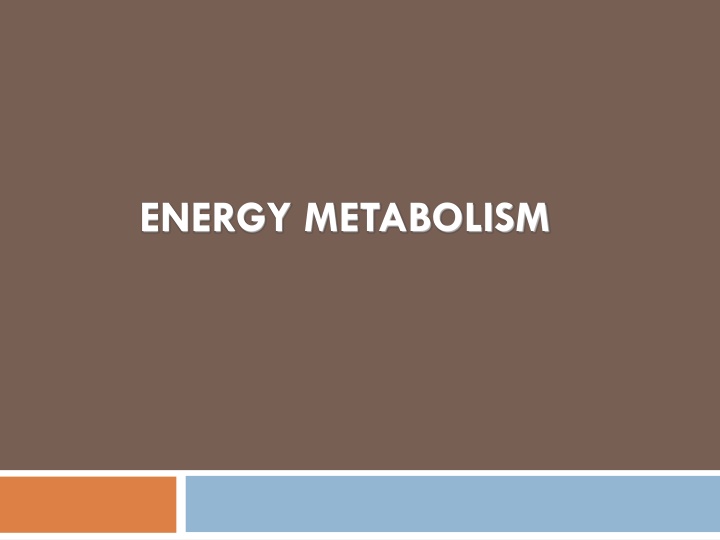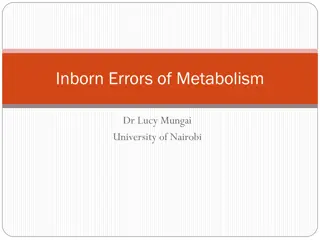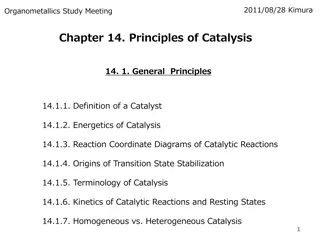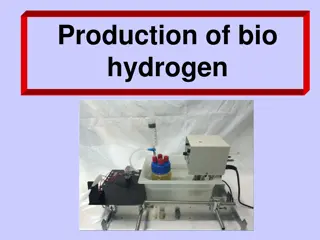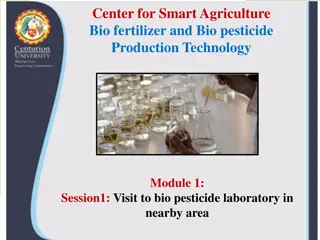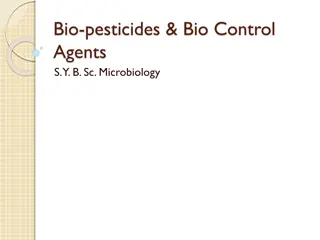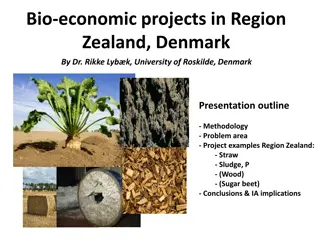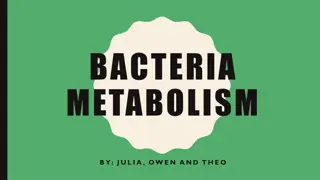Energy Metabolism and Bio-Energetics Overview
The intricate processes involved in energy metabolism and bio-energetics in biological systems, including energy maintenance, production, digestion, and partitioning. Learn about the transfer of energy, forms of energy, and calorimetry principles related to energy expenditure and thermodynamics.
Download Presentation

Please find below an Image/Link to download the presentation.
The content on the website is provided AS IS for your information and personal use only. It may not be sold, licensed, or shared on other websites without obtaining consent from the author.If you encounter any issues during the download, it is possible that the publisher has removed the file from their server.
You are allowed to download the files provided on this website for personal or commercial use, subject to the condition that they are used lawfully. All files are the property of their respective owners.
The content on the website is provided AS IS for your information and personal use only. It may not be sold, licensed, or shared on other websites without obtaining consent from the author.
E N D
Presentation Transcript
Energy Maintenance Production: Growth and development Milk synthesis Pregnancy Muscular contractions
Energy Total Digestible Nutrient (TDN) Non-fiber carbohydrates (NFC) Non-structural carbohydrates (NSC) Digestible Energy (DE), Metabolizable Energy (ME), Net Energy (NE)
Introduction The capacity of a system to do work Bio-energetic: transfer of energy through a biological system Forms: Kinetic Potential Light, heat, ionizing radiation, sound
Bio-energetics Energy expenditure/time Example: Mcal/day, Kj/day Joule (J) kg m2/s2 mass distance time Calorie heat produced by combustion
Bio-energetics The heat required to increase the temperature of 1 gram H2O by 1 degree centigrade (14.5 to 15.5) when the specific heat of H2O is 4.184 J/g Accounting of enthalpies of the reactions from changes in the body Based on the first law of thermodynamics E = q w where E is the change in internal energy of the system, q is amount of heat absorbed by the system, w is work done by the system
Bio-energetics Combustion of 1 mole glucose by O2 C6H12O6 + 6 O2 = 6 CO2 + 6 H2O E= - 2803.1 kJ/mol (enthalpy of combustion) Enthalpy= difference b/w heats of formation of products vs. reactants C + O2=CO2 E = - 393.5 KJ/mol H2 + O2 = H2O E = - 285.8 KJ/mol (6 - 393.5) + (6 - 285.8) (-2803.1) = - 1273 KJ/mol (enthalpy of formation of 1 mol glucose)
Conservation of mass in an experiment with a calf confined in a respiration chamber for 4 days(Blaxter, 1989) Input Wt. (g) Output Wt. (g) BWT 36,450 BWT 35,846 Food 12,040 Feces 272 Water 1,600 urine 10,164 Oxygen 2,480 H2O 3,596 evaporated CO2 2,640 CH4 14 Hair/skin 28 Total 52,570 total 52,560
Example: Item Lactating cow Pig; growing Percentages cow vs. pig GE 93 Mcal/d 8,600 Kcal/d - Fecal energy 29 344 5.4% vs. 1.86% Urinary energy 5 160 CH4 energy 2.8 320 Heat energy 31 3900 Milk energy 21 -
Measures Total digestible nutrients (TDN) = digestible [CP + NFE + CF + (2.25 EE)] +) ease of measurement/calculation -) underestimates high fiber feedstuffs can t take into account all losses ~ 1 kg TDN = 4.4 Mcal DE
Urinary & gaseous energy losses Urinary: average ~ 3% of energy intake Ruminants: 60 KJ/g N Pigs: 40 KJ/g N Relatively variable (esp. in high protein diets) Gaseous: production of CH4 High fiber diet vs. more soluble CHO diet ?
Net (retained) energy ME minus heat production Heat of nutrient metabolism (basal metabolism) Heat of activity Heat of thermal regulation Heat increment in a thermo-neutral environment, HI includes: - heat of digestion & absorption - heat of fermentation - heat of products formation - heat of waste formation
Basal (minimal) metabolism Strict Definition: heat production under the following conditions: Complete muscular repose Post-absorptive Thermo-neutral environment No stress
Fasting metabolism Energy used to maintain essential cellular functions (respiration, blood circulation, ) Which one is greater? basal or fasting Which one is feasible to conduct for farm animals?
How to attain a post-absorptive state? Mean retention time of food in gastro-intestinal tract Species Human Canine Pig Cat Time (hr) 46 23 43 60 Measures: CO2 produced; O2 consumed CO2/O2=RQ
Some historical events Lavoisier: larger animals produced more heat than small animals smaller animals produced more heat/unit BWT Rubner, 1883: fasting metabolism of dogs w/ diff. sizes close to constant when expressed per unit of body surface (m2)
Some historical events Viot, 1901: Kcal/m2 over 24 h Species BWT, kg Horse 441 948 Pig 128 1078 Man 65 1042 Chicken 2 943 mouse 0.018 1188
Metabolic body weight BWT 0.75 Not useful with newborn Brody & Kleiber Log equation; efficiency of food
Heat production Calorimetry - Direct: measure of heat loss by 1) sensible heat (radiation, conviction, conduction) and 2) evaporation heat (skin, lung) Direct Calorimetry: heat sink calorimeter Gradient layer calorimeter
Indirect Calorimetry Gaseous exchange O2 in CO2 out 1- whole animal-long term-respiration chamber 2- lung gaseous exchange-short term Uses mask, hood, or tracheal cannula Problem with mask ?
Heat of Combustion Values of the Protein and Fat in the Body and Wool of Sheep Paladines et al., 1964a
Indirect Calorimetry Net O2 consumption, CO2 production and heat similar over all reactions Heat production (HP) relates to feeds or body tissues Respiratory Quotients: CO2/O2
Respiratory Quotients Carbohydrates: 1 mol glucose + 6 O2 = 6 CO2 + 6 H2O + 673 Kcal HP = 5.005 Kcal/l O2 consumed Fat: 1 mol palmitate + 23 O2 = 16 CO2 + 16 H2O + 2398 Kcal HP = 4.653 Kcal/l O2 consumed RQ ranges from 0.7 to 1.0
Respiratory Quotients Non-protein RQ RQ adjusted for the amount of protein oxidized to urea Measure urinary N excreted: for each 1 g of N excreted 5.9 L O2 consumed & 4.76 L CO2 + 26.51 Kcal HP calculate proportion of fat & carbohydrate oxidized in feeds
Brouwer equation HP = 3.866 O2 + 1.2 CO2 0.518 CH4 1.43 N O2, CO2, CH4 in liter Generalized equation Some ignore O2 or CH4 ? (from Urinary N)
Closed Circuit Calorimetry Regnault-Reiset system: Same air re-circulate through the system short term Must be air-tight; maintain constant volume Must have absorbent (for CO2) Very accurate Not practical for farm animals
Open Circuit Calorimetry Pettenkofer system: - constant composition of air: 20.9% O2; 0.03% CO2 - Measures Vol. of air passing through + O2,CO2, CH4 in expired air - Fecal & urinary energy; urinary N; air flow; hair/skin (adult growth) losses Provides an estimate of HP Can be used for energy balance studies
Cont. What s the main reason to measure HP? EB = IE (FE + UE + Gas E + HP) Retained energy (energy balance)
Carbon-Nitrogen balance studies In conjunction w/ respiratory exchange studies Can be used to 1) estimate HP 2) body retention of fat & protein Body gain of C & N = C & N intake C & N output
Carbon-Nitrogen balance studies Assumption: Body protein contains 52.5% C & 16.7% N Body fat contains 76.5% C Glycogen is ignored Fat has 9.4 Kcal/g energy Protein has 5.7 Kcal/g energy
Calculating N balance NB = N Intake (FN + UN) N (g) 6.25 = protein accretion(g) protein accretion(g) 0.525 = C in protein accreted C Intake - C in protein accreted = C in fat accreted C in fat accreted / 0.765 = fat accretion (g) Limitations 1- difficult to measure all C & N losses 2- generally overestimates energy accretion Accuracy: measure enthalpies of combustion of energy of animal before/after treatments
Other methods Comparative slaughter studies Total body energy of a group (similar animals) at time 1 Total body energy of a similar group at time 2 Difference (T2 T1) = energy because of treatments Limitations: expensive, one-time point (not over time)
How is it done? Measure total body energy minus GI tract Grind, mix, take sub-sample Determine energy by bomb calorimeter Potential problems: animal variation sampling/representation water evaporation
Indirect methods to measure body composition Density fat has lower density vs. water, bone or protein decreasing density increasing fat stored Water density = 1.00
Density values of different tissues Tissue /species density Fat/ cattle 0.891- 0.912 Fat/ guinea pig 0.912 Fat/ human 0.918 Fat/ pig 0.914 Protein/ lean beef 1.312 Fat-free body/ human 1.100
How is it done? Submerge the animal Measure displacement in water Measure weight in water a body immersed in fluid is buoyed up with a force equal to the fluid displaced
Dilution methods If fat or non-fat portions of the body is known the enthalpy of combustion of the body can be estimated Need to know the fat-free body composition
Composition of the fat-free body Species BWT, kg Water, % Protein, % Ash, % rat 0.35 73.7 22.1 4.2 Cat 4.0 74.4 21.0 4.6 Man 65 72.8 19.4 7.8 Pig 125 75.6 19.6 4.7 ox 500 71.4 22.1 6.0
Age affects body composition (example: pigs; Spray & Widdowson, 1950) water percent protein Age
Deuterium oxide dilution method Can be applied to other methods using dyes Must be able to cross all cell membranes reach equilibrium with body water need accurate measurement slowly metabolized & excreted Water contents of body & feed??
Body Condition Score (BCS) BCS: non-invasive, qualitative ranging from 1 to 5 (no reserve to extremely fat) Optimum BCS at calving is ~ 3.5 Cows with BCS > 3.8 show increased risk for ketosis & mastitis
Body condition score change 4 3.75 Primiparous cows 3.5 BCS 3.25 Multiparous Cows 3 2.75 -4 -3 -2 -1 0 1 2 3 4 5 6 7 8 Week Relative to Parturition
Relationship of retained energy (RE) to food (energy) intake
The efficiency of utilization of energy curvilinear Retention (MJ) greater decline above zero retention 0 0 Energy Intake (MJ)
Cont. Why declining? Change in Metabolizability of the rations? More pronounced (greater decline) for ruminants vs. mono-gastric animals Is efficiency of utilization (k) different for maintenance vs. growth/lactation ?
